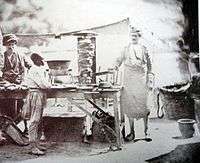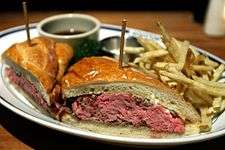Gyro (food)
|
| |
| Type | Meat or sandwich |
|---|---|
| Course | Main dish |
| Place of origin | Greece |
| Serving temperature | Hot |
| Main ingredients | Meat: beef, veal, mutton, pork, or chicken |
.jpg)
A gyro or gyros[lower-alpha 1] (Greek: γύρος, gyros [ˈʝiros], literally 'turn') is a Greek dish made of meat, traditionally pork, chicken, or lamb, and outside Greece with beef and veal, cooked on a vertical rotisserie, and usually served wrapped in a flatbread such as pita, with tomato, onion, tzatziki sauce, and sometimes french fries. Like the related dishes shawarma and tacos al pastor, it is derived from the doner kebab.
History

Grilling a vertical spit of stacked meat slices and cutting it off as it cooks was developed in Bursa[1] by Turks in the 19th century Ottoman Empire, and called doner kebab (Turkish: döner kebap). Following World War II, doner kebab was introduced in Athens by immigrants from Anatolia and the Middle East.[2] A distinct Greek variation developed, often made with pork and served with tzatziki sauce, which later became known as gyros.
By 1971, gyros sandwiches were already a popular fast food in Athens, as well as in Chicago and New York City.[3][4] In the US, gyros meat was typically made with beef and lamb. The earliest known American gyros meat mass-production plant was opened by John Garlic in Milwaukee. He later sold his interest in the business to Gyros, Inc. of Chicago, which along with Central Gyros Wholesale, and Kronos Foods, Inc, also of Chicago, began large-scale production in the mid-1970s.[4]
Name
The name comes from the Greek γύρος ("circle" or "turn"), and is a calque of the Turkish word döner, from dönmek, also meaning "turn".[5] It was originally called ντονέρ (pronounced [doˈner]) in Greece.[6] The word ντονέρ was criticized in mid-1970s Greece for being Turkish.[7] The word gyro or gyros was already in use in English by at least 1971,[3] and along with γύρος in Greek, eventually came to replace doner kebab for the Greek version of the dish.[6] Some Greek restaurants in the US, such as the Syntagma Square in New York City - which can be seen briefly in the 1976 film Taxi Driver[8] - continued to use both doner kebab and gyros for the same dish, in the 1970s.[9]
In contrast to other areas of Greece, in Athens the skewered meat dish souvlaki is known as kalamaki. A pita-wrapped sandwich made with either gyros meat or kalamaki is known as a souvlaki.
The Greek pronunciation is [ˈʝiros], but the pronunciation in English is often /ˈdʒaɪroʊ/ or, occasionally /ˈɡɪəroʊ/ or /ˈjɪəroʊ/.[10]
The final 's' of the Greek form is often reinterpreted as a plural in American English, leading to the formation of the singular "gyro". In Greek, "gyros" is a masculine noun, so is used with an "s" in the nominative case (Gyros is delicious), and without an s in the accusative case (I would like a gyro).
Preparation
Gyros may be considered a type of sandwich, and are differentiated from other hand-held semi-folded foods by their complete over-wrap but unsecured lower flap.
Traditionally, in Greece, the meat used is pork or chicken, while in restaurants outside Greece, lamb and beef are also commonly used. The meat is cut into approximately round, thin, flat slices, which are then stacked on the spit and seasoned. Fat trimmings are usually interspersed. Spice mixes generally include salt, hot and sweet paprika, white and black pepper, dried parsley, garlic powder, and oregano. Additional spices are sometimes added (e.g. cinnamon, nutmeg, cumin, anise, coriander, fennel, allspice, sumac).
The pieces of meat are placed on a tall vertical rotisserie, in the shape of an inverted cone, which turns slowly in front of a source of heat. Gyros are cooked on a vertical broiler, formerly using charcoal in a "cage", now either gas or electric. As the cone cooks, lower parts are basted with the juices running off the upper parts. If the meat is not fatty enough, strips of fat are added so that the roasting meat always remains moist and crisp. The rate of roasting can be adjusted by varying the strength of the heat, the distance between the heat and the meat, and the speed of the spit rotation, allowing the cook to adjust to varying rates of consumption. The outside of the meat is sliced vertically in thin, crisp shavings when done. It is generally served in an oiled, lightly grilled piece of pita, rolled up with sliced tomatoes, chopped onions, fries, and tzatziki.
Some mass produced gyros are made differently: lamb and beef meat is run through a four-ton grinder, where bread crumbs, water, oregano and other seasonings are added. A clumpy paste emerges and is squeezed into a machine that checks for metal and bone. Hydraulic pressure ― 60 pounds per square inch ― is used to fuse the meat into cylinders, which are stacked on trays and then rolled into a flash freezer, where the temperature is 20 degrees below zero. [11]
See also
Notes
- ↑ English: /ˈdʒaɪroʊ,
ˈʒɪəroʊ-, .ˈjɪər-, ˈɡɪər-/
References
- ↑ Kenneth F. Kiple, Kriemhild Coneè Ornelas, eds., Cambridge World History of Food, Cambridge, 2000. ISBN 0-521-40216-6. Vol. 2, p. 1147
- ↑ Simopoulos, Artemis P.; Bhat, Ramesh Venkataramana Bhat, eds. (2000). Street foods. Basel: Karger. p. 6. ISBN 9783805569279. OCLC 41711932.
- 1 2 "The Gyro, a Greek Sandwich, Selling Like Hot Dogs". The New York Times. September 4, 1971. p. 23. Retrieved February 22, 2016.
- 1 2 David Segal (July 14, 2009). "The Gyro's History Unfolds". The New York Times. Retrieved June 4, 2016.
- ↑ Babiniotis, Λεξικό της Ελληνικής Γλώσσας
- 1 2 Aglaia Kremezi and Anissa Helou, "What's in a Dish's Name", "Food and Language", Proceedings of the Oxford Symposium on Food and Cookery, 2009, ISBN 190301879X
- ↑ Γιάκωβος Σ. Διζικιρικής, Να ξετουρκέψουμε τη γλώσσα μας 'Let Us De-Turkify our Language', Athens 1975, p. 62, proposes substituting γυριστό for ντονέρ, but The New York Times was already using the word gyro in English in 1971 (4 Sept. 23/1) according to the OED, 1993 online edition, s.v.
- ↑ Martin Scorsese (director) (1976). Taxi Driver (Motion picture). Columbia Pictures. Event occurs at 0:06:05.
- ↑ "(unknown title)". New York. 1971. vol. 4. Retrieved 2018-01-28.
doner kebab, also known as a gyro, the by-now-familiar compressed seasoned lamb cooked on a vertical rotisserie, slices of which are served as a sandwich on Greek pita bread
- ↑ "Jack in the Box rolls Greek gyro in 600 units", Nation's Restaurant News, December 21, 1992. article
- ↑ "Mysterious Origins of the Ubiquitous Gyro - The National Herald". www.thenationalherald.com.
| Look up gyros in Wiktionary, the free dictionary. |


